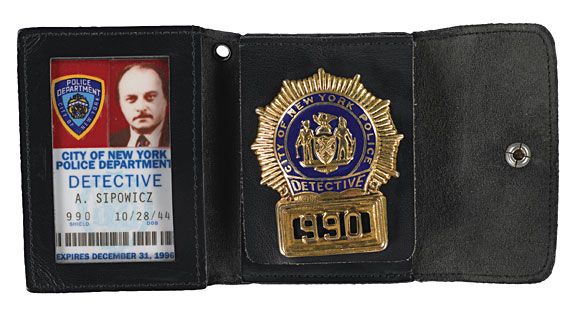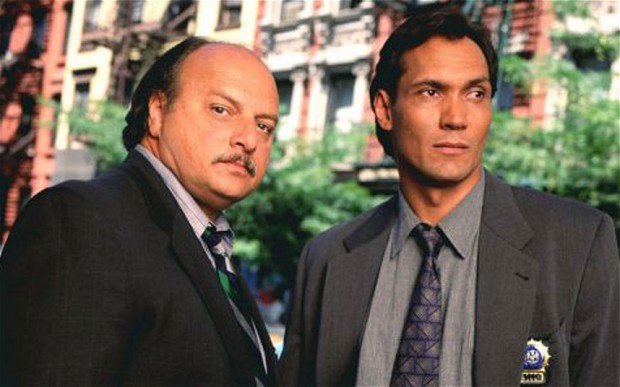
A troubled protagonist, gritty language, and a pair of bare buns changed the way America viewed TV cop shows forever.
L-R: David Caruso as Detective John Kelly and Dennis Franz as Detective Andy Sipowicz in the 1993 premiere season of NYPD Blue.
ABC’s NYPD Blue ended its 12-year, 261-episode run with new homicide squad commander Andy Sipowicz (Dennis Franz) sitting alone at his cluttered desk, facing an uncertain future, wondering perhaps how he ever wound up supervising the conduct of others after so much trouble supervising his own.
It was a fitting final image for the acclaimed police drama, which ultimately had evolved into a show mainly about Sipowicz. He had become a metaphor for the contemporary urban policeman who, after conquering his own demons, still has to face the daunting challenge of a bureaucracy that seems programmed to thwart justice at every turn.
 In the fall of 1993, when NYPD Blue began its run, it seemed most like a natural extension of writer-producer Steven Bochco’s experiments with Hill Street Blues, the most innovative and groundbreaking police show of the 1980s. Like Hill Street, it had a unique visual presentation—darker, busier and real. The handheld camera style gave us the feeling we were visiting a real New York police precinct where each frame seemed crammed with suspects in handcuffs or anonymous uniformed officers in blue.
In the fall of 1993, when NYPD Blue began its run, it seemed most like a natural extension of writer-producer Steven Bochco’s experiments with Hill Street Blues, the most innovative and groundbreaking police show of the 1980s. Like Hill Street, it had a unique visual presentation—darker, busier and real. The handheld camera style gave us the feeling we were visiting a real New York police precinct where each frame seemed crammed with suspects in handcuffs or anonymous uniformed officers in blue.
Steven Bochco
But television had undergone a major sea change since the run of Hill Street from 1981-87. Cable TV networks like HBO and Showtime were now doing weekly series—and doing them without the inhibitions of regulated broadcast networks. Doing a conventional police show built around a star name no longer seemed practical. Pushing the envelope did.
I remember grinning broadly when I first sat down to preview the pilot episode of NYPD Blue in the spring of 1993 and realized Bochco and partner David Milch had punched holes in the envelope in less than five minutes. Detective Sipowicz had just infuriated prosecutor Sylvia Costas (Sharon Lawrence) by ruining her case against a mobster with contaminated evidence. On the way out of the courthouse, she mumbles her displeasure and Sipowicz rather flagrantly expressed his own.
“Ipso this,” said Sipowicz, clutching at his crotch, “you pissy little bitch!”
Well, that was certainly something you didn’t hear on broadcast television in 1993, even after 10 pm.
As the pilot rolled on, things got even more envelope-punchy as Detective John Kelly (David Caruso) and Officer Janice Licalsi (Amy Brenneman) made love for the first time—and we saw parts of their naked bodies never before seen in a commercial network prime time program. Though little publicized at the time, it eventually came out that NYPD Blue had required all its actors to sign “nudity clauses” in their contracts, guaranteeing no disputes over being asked to appear in such scenes.
After the ABC affiliates convention that year, a furor began that quickly equaled and surpassed the one over ABC’s raunchy comedy series Soap in 1977. A large number of ABC stations complained they wouldn’t show that episode unless significant changes were made. Some warned they wouldn’t clear the series at all for their stations.
Eventually, a new pilot was produced, trimming 15 seconds of nudity from the bedroom scene. As producer Bochco explained when I asked him about it, they didn’t cut what we saw, just how long we saw it. In a rather testy press conference that July, Bochco blamed the press for blowing up the controversy.
 “We’re not doing anything that’s going to bring down the fall of the Republic,” he said. True enough, but what NYPD Blue did do was revolutionize broadcast television standards. By winning the battle to include nudity, a major step was taken that other dramatic shows cautiously followed. By getting ABC to agree to a list of profane words that were acceptable—if not used to excess—Bochco hastened the rush of commercial TV producers to compete with the booming popularity of HBO and its fellow cable networks. The result was enormous publicity, immediate hit status for NYPD Blue and overnight fame for its lead actor, David Caruso, who quickly began to receive tempting offers for lead roles in movies. His requests for special scheduling, so he could go off to star in movies, were deemed unacceptable by Bochco and Milch, who knew they had a tiger by the tail. When negotiations failed, Caruso decided to break his contract and leave the show early in the second year.
“We’re not doing anything that’s going to bring down the fall of the Republic,” he said. True enough, but what NYPD Blue did do was revolutionize broadcast television standards. By winning the battle to include nudity, a major step was taken that other dramatic shows cautiously followed. By getting ABC to agree to a list of profane words that were acceptable—if not used to excess—Bochco hastened the rush of commercial TV producers to compete with the booming popularity of HBO and its fellow cable networks. The result was enormous publicity, immediate hit status for NYPD Blue and overnight fame for its lead actor, David Caruso, who quickly began to receive tempting offers for lead roles in movies. His requests for special scheduling, so he could go off to star in movies, were deemed unacceptable by Bochco and Milch, who knew they had a tiger by the tail. When negotiations failed, Caruso decided to break his contract and leave the show early in the second year.
That calamity changed the course of NYPD Blue forever. It forced the writers to re-focus the show onto Sipowicz, who was the partner to Detective Kelly. He was a most unlikely fellow to be the central character in any show. He was a drunk, a racist, an adulterer who frequented prostitutes and was played by a balding, overweight, middleaged actor whose face would never appear on a Wheaties box.
But Bochco and his fellow writers had transformed a Dennis Franz character from heel to hero before. In Hill Street Blues, Franz had played a bad cop so well that Bochco decided to bring him back as a series regular, playing Lt. Norman Buntz (1985-87), a cop very much like Andy Sipowicz. The Buntz character was so popular in fact that he briefly starred in his own quasisitcom, Beverly Hills Buntz (1987-88) after leaving the force and becoming a private eye in L.A.
Franz is a funny, loveable guy in person—so it must have been a special treat for him to tackle a character like Sipowicz, so dark at first meeting. He eventually romanced and married Sylvia, the “pissy little bitch” from the series pilot, and even played his mandatory nude scene with her in a sequence in which the grossly overweight Franz and shapely Sharon Lawrence took a memorable shower together.
 Dennis Franz and Jimmy Smits
Dennis Franz and Jimmy Smits
Even after actor Jimmy Smits—from Bochco’s L.A. Law—was hired to play Detective Bobby Simone, Sipowicz’s new partner, the Sipowicz character remained central. When Smits left the series a few years later, the subsequent new partners were clearly subordinate to Franz’s Sipowicz. The series remained a big ratings winner for ABC until the last few years when Bochco and Milch concentrated on other projects and the remaining writers turned the show in a new, lighter direction. The trend in television was toward the even more realistic forensic and police procedural shows like the CSI and Law & Order franchises while NYPD Blue remained a character-driven series. Interest in Sipowicz waned and none of the newer characters really caught fire with the public.
After 12 seasons, however, the legacy of NYPD Blue seems solid. It was the program that turned the police show in a much more reality based direction and made the large ensemble cast almost standard for the genre. The influence of real-life former New York police detective Bill Clark as adviser and, later, an executive producer is undeniable.
In the course of those 12 seasons, Andy Sipowicz was very nearly rehabilitated for good. No longer a self-destructive force, he became a mentor and, in the final episode, the leader of his squad. Naturally, though, his history haunts him and it’s not too big a stretch to imagine him losing it completely one of these days and punching out one of those arrogant chiefs above him.
Maybe, if we’re lucky, we’ll get to see it in a NYPD Blue reunion movie.


